Review for Clannad After Story Part 2
Introduction
The Clannad saga has seen the Key Visual/Kyoto Animation collaboration at its finest, emotional manipulation of the viewer refined to an art form, as its story has taken us on a roller coaster ride of highs and lows, gentle angst and subtle heartbreak that’s designed to leave the viewer teetering on the brink of despair, before pulling it all back with an moment of vicarious joy that lifts the heart once more. For this final collection of episodes however, Clannad After Story threatens to depart from the carefully designed roller coaster, and instead go into full runaway train mode. Not all of us may make it through this story, and even the stoutest of hearts may run out of Kleenex halfway through. I’m bolstering my viewing with as much light, fluffy and bunny filled joy as possible, to keep me from tipping over the brink.
Tomoya Okazaki is a young boy with a dark past. His relationship with his alcoholic father has degenerated into total non-communication, and this has affected his school life to such a degree that he’s considered a delinquent, along with his best friend Youhei Sunohara. Delinquency in this case means just going through the motions at school, turning up because there is nothing better to do, and spending the day staring aimlessly out of the window. His life begins to change however when he meets something of a kindred spirit. Nagisa Furukawa is also an outcast at school, although in her case it’s not through choice. She’s been ill for the past year, and is now repeating her classes. Shy and timid, she hasn’t made any friends in the new school year, and hardly anyone is aware of her existence. But chatting to Tomoya helps her open up, and she reveals a passion for drama. When Tomoya decides to help her reopen the school’s drama club, it sparks off a chain of events that leads him to meet some very remarkable girls at school, and come face to face with some unsettling mysteries.
That was Clannad, but now we’re well into the sequel, Clannad After Story, which began where Clannad left off with a few mysteries yet to solve, and a few characters whose lives needed meddling in. But at the end of the previous volume, a disruptive event in Tomoya’s life triggered the next phase of his relationship with Nagisa, their becoming a family. But life isn’t easy for the happy couple...
The concluding thirteen episodes of Clannad After Story are presented across three discs.
Disc 1
13. Graduation
14. A New Family
15. In the Remains of Summer
16. White Darkness
Disc 2
17. Summer Time
18. The Ends of the Earth
19. The Road Home
20. The Mischievous Sea Breeze
Disc 3
21. The End of the World
22. A Small Hand
23. Extra Chapter: Events from a Year Ago
24. Another World ~ Kyou Arc
25. Summary ~ Under the Green Tree
Picture
Just like the first series, Clannad After Story gets a 1.78:1 anamorphic transfer, which courtesy of Australia’s Siren Visual is a native PAL transfer with the 4% speedup that implies. The image is clear and sharp throughout, the animation is smooth and free of compression artefacts, and watching these episodes I had no cause for complaint. The animation is gorgeous. If you’ve seen any anime from studio KyoAni, such as The Melancholy of Haruhi Suzumiya, then you’ll know how much effort they put into creating consistent and appealing world and character designs. Just like Key/Visual’s Kanon before it, Clannad After Story too creates and idealised, warm and sympathetic world, using colours, light and atmosphere to draw the viewer in, and filling the world with cute and charming character designs. Watching an episode of Clannad is like spending 20 minutes in a sweet shop. It’s an animation that just glows.
Sound
You have the choice between DD 2.0 English and DD 2.0 Japanese, and this being a Siren sourced disc, the audio will default the Japanese. Of course you have the optional translated subtitles and a signs only track. I went with the original language audio, and was very happy with the actor performances and the overall experience. Clannad After Story gets a very agreeable music soundtrack, with some very nice theme songs, and incidental music that suits the story perfectly. I tried the English dub, and couldn’t bear more than ten minutes of it. It’s one where the voice actresses try to emulate the original performances too closely, and it always sounds forced to me and unnatural. Of course your mileage may vary.
The problem with Clannad’s subtitle stream getting mixed up with the screen captions has been resolved for the sequel series, and the text captions get nice constant placement on screen even when dialogue is occurring. You don’t miss a thing. There was a missing subtitle caption in episode 22, but fortunately it’s one of those statements that are repeated by a character as a question, so you don’t miss out.
Extras
Three discs come with static menus, and a language select option. You have to play the episodes one by one. There is no Play All option. Each episode ends with an extra 90-second English language credit reel over a black background.
There are no extra features with this collection.
Conclusion
You know that I’m not going to talk about this collection of episodes! We’re talking almighty, massive spoilers here. With Clannad After Story, and especially the second half of the show, we get that situation where the narrative is intricately woven into the emotional arcs of the characters, and even mentioning some of the events that happen in this collection of episodes will be like giving away the ending to the Sixth Sense, only several times over. I wouldn’t do that to my worst enemy. Well maybe my worst enemy, but I doubt they watch anime. I can talk around the episodes, point out little trivialities, but talking about a baseball game, a train journey, or a star-shaped bread really means nothing out of context, while I can mention that the perky end theme after episode 16 is wholly out of place, while the same song after episode 17 has never been more appropriate. And none of that will mean anything to you.
With this final volume, Clannad cements itself as a true Marmite experience, you’ll either love it or loathe, but I doubt that there will be much middle ground. I’m firmly of the former opinion, mostly because I allowed myself to become invested in the characters and went on the emotional big dipper with them over the course of these episodes. If I step outside myself and try to view Clannad After Story pragmatically, I can see how it might leave people cold.
The main reason is that this is where Key Visual hit their peak when it comes to their brand of storytelling. It’s an approach that demands that the viewer suspend their disbelief, and invests fully in the characters and what happens to them. Key Visual’s style is to pitch a light, fluffy, warm comedy drama at you, then suddenly blindside you with a bit of tragedy to elicit some tears. Then it will go back to the light and fluffy before presenting a bit more tragedy. It’s written to perfection, paced without flaw, a storytelling technique that is micro metered and finely honed through several series, culminating perhaps in the finest exponent of their art, Clannad. It’s an approach that demands that you be actively complicit in having your emotions manipulated, and if you fail to do that, then the show will leave you cold. It’s the characters, the voice acting, and the animation and music which make it easy to forge that contract.
With Clannad After Story, they really do go for the kill, offering tragedy and joy in alternation once more, but doing so to a degree that they have never before managed. The tragedy here is heartbreaking in the extreme, and the joy that follows is such a release, that it elicits even more tears, simply of relief. With a show like Kanon, it dealt its stories in terms of supernatural fantasy and unrealism, before taking a more realistic and believable approach for its final arc. In Clannad After Story, that final tragedy is so bleak, so heart wrenching, and so final, that no realistic way of resolving it exists, and so in its last gasp, Clannad After Story resorts to pure fantastic hand-waving to deliver that final hit of joy and relief. It’s the one weak point of the show, in that it writes itself into a corner that it can’t resolve without ‘cheating’. Then again, that cheat was set up from the opening episode when the girl and her robot were introduced. The meaning of the two otherworldly characters becomes clear at last here, and it does at least remain consistent with the world that Clannad has established.
One thing that I must say, is that invested as I was, appreciative as I am of this show, the extremes that Clannad After Story goes to for its final arc even had me feeling a little resentful of having my emotions so blatantly manipulated, even while I was aware of, and was complicit in allowing such manipulation. Clannad After Story loses subtlety for its conclusion, and that is a little disappointing. I find that I prefer Kanon with the way it tells its tale, as it doesn’t strain the bounds of its self defined fantasy.
The story itself concludes at episode 22, and the collection rounds off with three bonus episodes, the first of which is the best. The extra chapter serves as a prequel to the Clannad story, and follows the students as they start their senior year at high school. It’s set before Nagisa and Tomoya had their fateful first encounter on the hill, and shows that he had a part to play in her life even before that. It’s also full of the typical light comedy associated with the early part of the series, and contrasts nicely with the tearful conclusion.
Clannad also concluded with a couple of bonus episodes, and one of them was a what if, one of those alternate game paths through a Key Visual videogame title that saw Tomoya hook up with Tomoyo. The second bonus episode in After Story is another 'what if' episode, that has Tomoya having to choose between the twins Kyou and Ryou, and the heartache that ensues. This isn’t as good as the Tomoyo story, and never really tugs on the heartstrings, although that may be down to said heartstrings being strained beyond repair after the conclusion of the main story. Finally there is an episode where Tomoya tells the tale of how he and Nagisa got together. It’s a recap episode, and other than the last five minutes, it can be dispensed with.
Don’t get me wrong. I love Clannad and Clannad After Story, and I wholeheartedly recommend both seasons to anyone who’s willing to suspend their disbelief and enter into the contract to have their emotions manipulated wholesale. It’s just that I saw Kanon first, and I like that show a lot more. I just feel that Clannad isn’t as deft with its storytelling, and on occasion its attempts to elicit just one more crying jag result in some overt heavy-handedness.
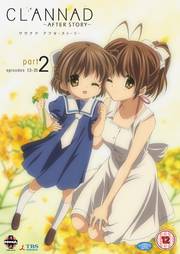




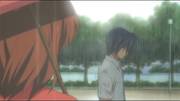

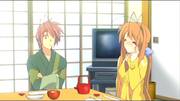
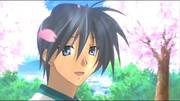

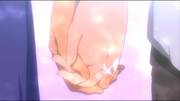
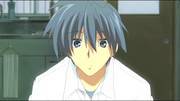

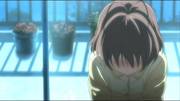

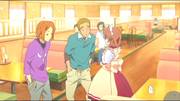
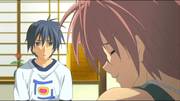


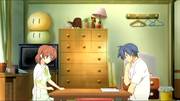




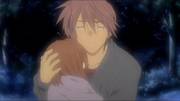

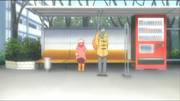

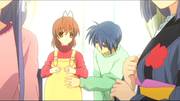




































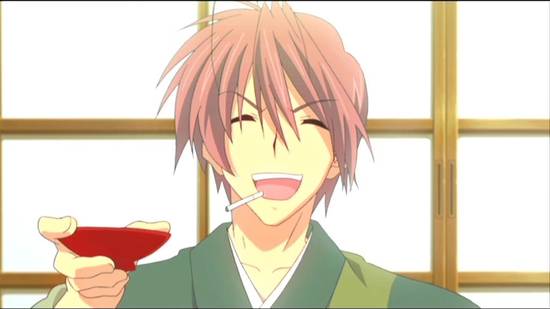







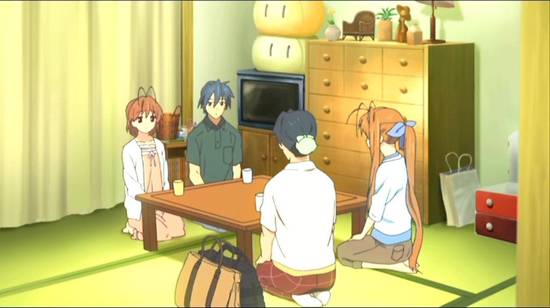




Your Opinions and Comments
Be the first to post a comment!